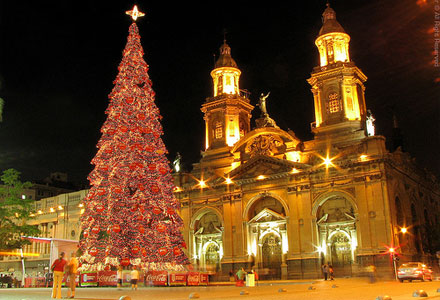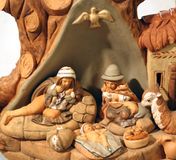Welcome To Christmas Around The World
Learn How Other Children Celebrate Christmas From Different Countries!
Christmas In
South America
Say Merry Christmas in South America
(Español) - Feliz Navidad or Nochebuena (which means 'Holy Night' - Christmas Eve)
 CHRISTMASTIME ALL OVER South America seems to emulate ideas from the Northern Hemisphere holiday. Rich families decorate their houses just like a vintage Coca-Cola ad, socks are hung over fireplaces devoid of fires, and artificial snow is painted all over the place.
CHRISTMASTIME ALL OVER South America seems to emulate ideas from the Northern Hemisphere holiday. Rich families decorate their houses just like a vintage Coca-Cola ad, socks are hung over fireplaces devoid of fires, and artificial snow is painted all over the place.
Decoration is the key, whether you’re rich or poor. Unlike the Christmas trees from Hollywood films, families use plastic ones that are supposed to be replaced once every seven years (in Argentina it’s bad luck if you don’t!).
Santa Claus is known by many other names on the continent: “Papai/Papá Noel,” “San Nicolás,” “Viejito Pascuero,” and “el gordo de Navidad” (which also happens to be a major prize in the national Argentine lottery around this time of year). It’s not unlikely to have a family member (usually the crazy, drunk uncle) dressed as Papá Noel distributing gifts for the children, while the little ones make an effort to unmask the true identity of the fat guy carrying gifts.
Christmas is Navidad in Spanish or Natal in Portuguese, both words coming from nacimiento (birth). In Spanish, “eve” is translated as víspera, but we also use other terms: Christmas Eve is noche buena (“good night”) or noite feliz (“happy night”), and if you want to ask someone where he or she is spending New Year’s Eve, you actually say ¿dónde pasas las 12? (“where are you going to be at midnight?”). Midnight is the moment everybody awaits to celebrate with fireworks, gift exchanging, and lots of drinking. For both Christmas and New Year, people usually spend the dinner with family and then go party with friends after 2-3am.
Here are some other unique aspects of Christmas in South America.
The food
 In Argentina, for both Christmas and New Year, people eat lamb, pork, and lots of sweets — the pan dulce (a vanilla bread with nuts, almonds, raisins, chocolate chips, and dried fruits) being the thing you have to eat. Ecuadorians enjoy a rich diet too: pristiños, buñuelos con miel with chocolate milk, tamales, and humitas, among other traditional dishes. Roasts (chicken, turkey, and the mystery poultry called “chester”) and farofas with dried fruits are common, as well as cuscus. Eggnog is almost unheard of, but there’s a lot of beer, wine, and a local cheap version of hard apple cider called cidra.
In Argentina, for both Christmas and New Year, people eat lamb, pork, and lots of sweets — the pan dulce (a vanilla bread with nuts, almonds, raisins, chocolate chips, and dried fruits) being the thing you have to eat. Ecuadorians enjoy a rich diet too: pristiños, buñuelos con miel with chocolate milk, tamales, and humitas, among other traditional dishes. Roasts (chicken, turkey, and the mystery poultry called “chester”) and farofas with dried fruits are common, as well as cuscus. Eggnog is almost unheard of, but there’s a lot of beer, wine, and a local cheap version of hard apple cider called cidra.
In Brazil, the traditional Italian sweet bread panetone is hugely popular, often offered from one family to another during holiday week. But here’s the Brazilian twist: Not happy with the usual dried fruits flavour, the markets have been invaded by chocolate, brigadeiro, dulce de leche, sweet guava, and many other versions, each one sweeter than the next. There are also salted versions using pork and chicken.
Christian like traditions
South America inherited Christianity from its European colonizers, but each country has its own profane/sacred approach to it. Kids reenact the birth of Jesus at schools and churches celebrate Mass, but there’s also dancing, fires, and chants that very much echo pagan traditions.
 The Brazilian countryside celebration of Folia de Reis happens between Christmas Eve and early January. It’s a tradition inherited from the Portuguese, honoring the three wise men who visited baby Jesus when he was born. It happens in all five Brazilian regions and, although each city and village possesses its own traditions, there’s always a choir, dancing clowns, a ceremony master, a trio representing the magi, and a flag-man carrying the group banner.
The Brazilian countryside celebration of Folia de Reis happens between Christmas Eve and early January. It’s a tradition inherited from the Portuguese, honoring the three wise men who visited baby Jesus when he was born. It happens in all five Brazilian regions and, although each city and village possesses its own traditions, there’s always a choir, dancing clowns, a ceremony master, a trio representing the magi, and a flag-man carrying the group banner.
In the city of La Plata (one hour from Buenos Aires), another tradition with mixed origins was created. Locals spend a lot of time building huge paper and cardboard dolls that they set on fire on New Years. People compete to have the best, the funniest, the most controversial paper puppets — it can get very political too, with representations pro and against governments.
3. Traffic jams in Rio / São Paulo vs. the emptiness of Buenos Aires
In São Paulo and Rio, people enjoy the strange habit of entering a vehicle and driving past the hugely popular Christmas trees set up on Ibirapuera (São Paulo) and Lagoa (Rio) — only to get stuck in major traffic jams. It can go on all night and is particularly bad during weekends. But there’s more: Paulista Avenue in São Paulo is well known for its annual holiday decorations, and people come from all around to enjoy it. How? From inside their cars, of course.
In Buenos Aires, on the other hand, la city porteña seems to be empty of people between Christmas and New Year. Those who have office jobs take the week off if they can afford to, and many companies embrace the fact that nothing gets done during that time. The exception is sometimes the Congress, which has a reputation for taking advantage of the Christmas-y distractions and passing controversial laws during the holidays.
Hace calor
 “Santa should wear flip flops.” Poor crazy uncle, sweating inside his heavy red Christmas suit. It’s high summer in South America, and very hot. Many cities will host festivities on the streets, and people like to enjoy the fireworks, sing villancicos, and host neighborhood parties after midnight. December 25 and Jan 1 are often spent at the houses of those with swimming pools.
“Santa should wear flip flops.” Poor crazy uncle, sweating inside his heavy red Christmas suit. It’s high summer in South America, and very hot. Many cities will host festivities on the streets, and people like to enjoy the fireworks, sing villancicos, and host neighborhood parties after midnight. December 25 and Jan 1 are often spent at the houses of those with swimming pools.
Nativity scenes everywhere
 Nativity scenes are very common, on the streets and inside houses — with both great and horrible results, of course. In Quito, Ecuador, for instance, there are pesebre competitions and a giant nativity scene is held over the Panecillo. In small cities all over Brazil, the central praça will have its version set inside a bandstand, often created by children (sometimes using recycled material).
Nativity scenes are very common, on the streets and inside houses — with both great and horrible results, of course. In Quito, Ecuador, for instance, there are pesebre competitions and a giant nativity scene is held over the Panecillo. In small cities all over Brazil, the central praça will have its version set inside a bandstand, often created by children (sometimes using recycled material).
6. The darker side
Every year, scores of people die on the night of Natal. Newspapers around South America report that between Christmas Eve and New Year the suicide rate peaks. Some experts say it’s a bad combination of not having met the expectations for the past year and feeling lonely in a time of family gatherings. Christmas night also sees a lot of drunk driving, both in big cities and on countryside highways.
Although it happens all over South America, in Argentina fireworks are very popular — and dangerous. Accidents occurs all night due to misuse or illegal products that blow up unexpectedly, and sadly kids under 15 are hurt most often.
In Brazil’s southeast this is the rainy season, with sometimes devastating effects. Unfortunately, you might wake up after a fun night of celebrations to discover on the news tragic events that took place the previous night.
Midnight Mass
The Missa do Galo or Misa de Gallo is a traditional Christmas Mass celebrated in all Catholic countries, but it becomes a huge event in South America. It starts right after Christmas Eve dinner, and it’s not uncommon for Catholic families to watch it together on television. The Portuguese/Spanish name derives from the fact that the Mass is so long that people don’t get home until the roosters are crowing. There’s candle lighting, chanting, and after Mass it’s time to put baby Jesus in the nativity scene.



Copyright © 1996 THE-NORTH-POLE.COM Designed by LeNewit.com
HOME | ABOUT | PRIVACY POLICY | TERMS OF USE | CONTACT US

